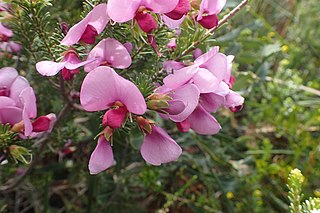
Gompholobium scabrum is a species of flowering plant in the pea family Fabaceae and is endemic to the south-west of Western Australia. It is an erect to spreading shrub with linear leaves and pink or purple flowers with some darker markings.

Grevillea pterosperma, commonly known as desert grevillea or desert spider-flower, is a species of flowering plant in the family Proteaceae and is endemic to continental Australia. It is an erect, rounded shrub with linear leaves, sometimes divided with up to six linear lobes, and cylindrical clusters of greyish white and creamy white flowers with a cream-coloured to pale yellow style.

Eremophila tietkensii is a flowering plant in the figwort family, Scrophulariaceae and is endemic to Australia. It is a rounded to flat-topped shrub with grey-green leaves, usually pinkish-purple sepals and mauve, pink or lilac-coloured petals. It is mostly found in Western Australia but also occurs in the far west of the Northern Territory.

Leucopogon plumuliflorus is a species of flowering plant in the heath family Ericaceae and is endemic to the south-west of Western Australia. It is a weakly erect shrub with egg-shaped leaves and spikes of white or pinkish-white, tube-shaped flowers.
Goodenia elderi is a species of flowering plant in the family Goodeniaceae and is endemic to inland areas of Western Australia. It is an erect or virgate shrub with linear, more or less bunched stem leaves, and spreading racemes of white or yellow flowers.
Dillwynia divaricata is a species of flowering plant in the family Fabaceae and is endemic to the south-west of Western Australia. It is an erect, spindly shrub with cylindrical, grooved leaves and yellow flowers with brownish markings.

Gompholobium capitatum, commonly known as yellow pea, is a species of flowering plant in the family Fabaceae and is endemic to the south-west of Western Australia. It a slender, erect or ascending shrub with pinnate leaves and yellow flowers.

Gompholobium cyaninum is a species of flowering plant in the family Fabaceae and is endemic to the south-west of Western Australia. It is an erect to straggling shrub with pinnate leaves and blue, purple and red, pea-like flowers.
Gompholobium glutinosum is a species of flowering plant in the family Fabaceae and is endemic to the far west of Western Australia. It is an erect, openly-branched shrub with pinnate leaves with three to five leaflets, and yellow and red, pea-like flowers.
Gompholobium gompholobioides is a species of flowering plant in the family Fabaceae and is endemic to the south-west of Western Australia. It is a spreading shrub with pinnate leaves and uniformly yellow, pea-like flowers.
Gompholobium laxum is a species of flowering plant in the family Fabaceae and is endemic to the south-west of Western Australia. It is an erect, open shrub with needle-shaped leaves and uniformly yellow, pea-like flowers.
Gompholobium muticum is a species of flowering plant in the family Fabaceae and is endemic to the south-west of Western Australia. It is a low, bushy shrub with grooved, cylindrical leaves and pink or green, pea-like flowers.
Gompholobium polyzygum is a species of flowering plant in the family Fabaceae and is endemic to north-western Australia. It is an erect or prostrate shrub with pinnate leaves each with sixteen to twenty-one pairs of leaflets, and yellow-orange and greenish, pea-like flowers.
Gompholobium pungens is a species of flowering plant in the family Fabaceae and is endemic to the south-west of Western Australia. It is an erect, openly-branched shrub with spiny stems, pinnate leaves and mostly yellow, pea-like flowers with pink or purple markings.
Gompholobium roseum is a species of flowering plant in the family Fabaceae and is endemic to the south-west of Western Australia. It is an erect shrub with pinnate leaves and yellow, pink or green, pea-like flowers with pink or green markings.

Gompholobium shuttleworthii is a species of flowering plant in the pea family Fabaceae and is endemic to the south-west of Western Australia. It is an erect shrub with pinnate leaves with five to nine leaflets, and pink or purple flowers with some darker markings.
Gompholobium subulatum is a species of flowering plant in the pea family Fabaceae and is endemic to northern Australia. It is a slender, erect shrub with pinnate leaves with five to eleven leaflets, and uniformly yellow, pea-like flowers.

Gompholobium tomentosum, commonly known as hairy yellow pea, is a species of flowering plant in the pea family Fabaceae and is endemic to the south-west of Western Australia. It is an erect shrub with hairy foliage, pinnate leaves with five to seven leaflets, and uniformly yellow, pea-like flowers.

Gompholobium villosum is a species of flowering plant in the pea family Fabaceae and is endemic to the south-west of Western Australia. It is a slender, erect shrub with simple, needle-shaped leaves with one or two grooves on the lower surface, and violet, pink or purple flowers.
Gompholobium wonganense is a species of flowering plant in the family Fabaceae and is endemic to the Wongan Hills area of Western Australia. It is an erect, spreading shrub with simple leaves and uniformly yellow, pea-like flowers.








